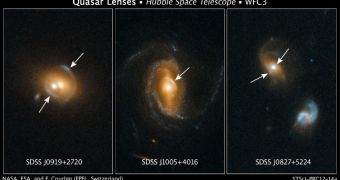Quasi-stellar radio sources (quasars) are notoriously difficult to study, due to the fact that they are extremely bright, more so than the galaxies which they inhabit. Now, astronomers propose a new method for studying these objects, which can also help them calculate the host galaxy's mass.
Quasars are very active, supermassive black holes that release vast volumes of radiations from their poles. These radiations are produced by a wide array of phenomena happening around the event horizon. Such objects are usually located at least several billion light-years from Earth.
Due to their extreme brightness, they easily overwhelm the glow of stars around them, making it very hard for experts to measure the mass of their host galaxies. But doing so may be possible if the correct galactic alignments are found.
Scientists determined recently that correctly-aligned galaxies give rise to an optical phenomenon called gravitational lensing. Studies can only be conducted on galaxies that are placed in a straight line as seen from Earth, with the nearest one standing directly in front of the background one.
What this does is enable the first galaxy in the “string” to act like a massive cosmic magnifying glass. The effect is made possible by the fact that massive gravitational pulls distort the path of photons.
Light is therefore literally bent around the foreground galaxy. The reason why gravitational lensing is an appropriate method to use for studying the mass of galaxies hosting quasars is that the phenomenon enables astronomers to measure light distortions produced by the background galaxy.
The new investigation was conducted by an international team of astronomers, which also included NASA Jet Propulsion Laboratory (JPL) expert Daniel Stern. The group says that only alignments where a quasar is located in the foreground galaxy can be used for this specific type of study.
“The amount of the background galaxy's distortion can be used to accurately measure the lensing galaxy's mass,” experts at the JPL explain in a press release. Thus far, experts only managed to find a handful of appropriate galactic alignments.
They are optimistic that additional surveys, conducted with the NASA/ESA Hubble Space Telescope and other space- and ground-based assets, will reveal more such scenarios.
In time, astronomers want to build a catalog of such aligned galaxies, in hopes that this will provide additional insight into galactic evolution, black hole feeding and growth, and stellar formation.

 14 DAY TRIAL //
14 DAY TRIAL //